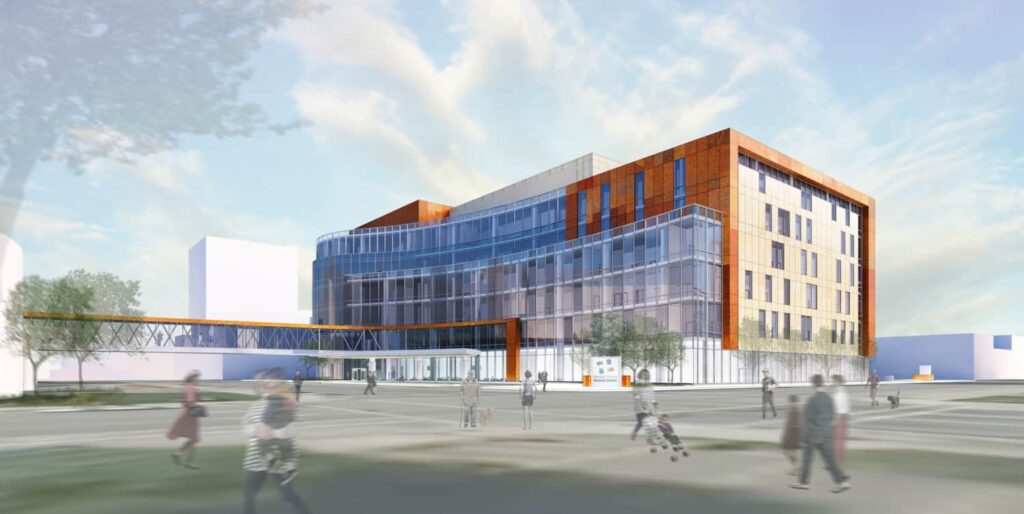Hennepin County Medical Center broke ground on its BWBR-designed ambulatory clinic building Thursday, marking the biggest expansion in history for Minneapolis/Saint Paul’s largest teaching hospital. At the same time, the safety-net hospital also celebrated the inauguration of its second helistop located on top of the building housing the HCMC emergency department, operating rooms, and intensive care units, directly across the street from where the Ambulatory Outpatient Specialty Center will stand.
The $220.8 million, 377,000 s.f. ambulatory clinic building will consolidate over 40 primary and specialty clinics currently spread across 9 buildings. An HCMC commissioned study determined these buildings would reach maximum occupancy in a few years, leading to the decision to build the ASOC, according to Scott Wordelman, vice president of ambulatory delivery and support services at HCMC.
HCMC’s reorganization of nearly two million square feet will offer centralized and accessible care for people who need convenient access to a doctor, same day surgery, or cancer treatment in a growing residential population in downtown Minneapolis. The BWBR-designed Ambulatory Outpatient Specialty Center (AOSC) will be housed next door to Minnesota’s first Level I Trauma Center, Minnesota’s largest emergency department and busiest trauma center.
When it came time to find where and how HCMC might reconfigure the Minneapolis space best, the site made the most sense to transform underutilized parking lots into a center for healing, said Sharon Sayles Belton, chair of the Hennepin Healthcare System, Inc. board and former mayor of Minneapolis.
“The most rewarding moment in a project like this is when we’re able to actually begin to see the future evolve in the design of the new facility and we can begin moving with our staff towards delivering care in a new way,” Wordelman said.
“This has been extremely rewarding to work with HCMC staff and stakeholders to find a solution to the organization’s needs,” said Rick Dahl, AIA, principal at BWBR on the project. “This is a transformational project, both for this part of downtown Minneapolis and for the region’s health care needs. The facility will serve patients and the community for years to come in a facility that is welcoming, intuitive, and worth of the talents of the HCMC staff.”
Immediately following the clinic building groundbreaking, HCMC and guests welcomed the arrival of a Life Link III helicopter carrying 6-year-old Reagan Lennes and her mother Lisa who officially opened the new helistop. Reagan had flown to the Level I Pediatric Trauma Center just last year after an elevator accident from her hometown in Alexandria, Minn., but the flight on Thursday was celebratory as Reagan has made a remarkable recovery with the support of HCMC staff.
The new helistop doubles the capacity to receive trauma and critical care patients by air and reduces transport time into the hospital. The helipad is heated to melt snow and ice making it safer for staff and patients. The existing helistop sits atop a parking ramp on 6th Street and Park Ave., and will remain available if needed.
The AOSC building will include six floors of clinics and services, two levels of underground pay parking with 221-stalls for patients and family. The building will house primary, specialty care and physical and occupational therapy. As well as a same day surgery center with five operating rooms, and four GI/endoscopy rooms. The clinic will also be home to a Cancer Center with Radiation Therapy, Outpatient Imaging Center, Women’s Imaging, and skyway and tunnel connections to the rest of the HCMC campus.
In addition to HCMC staff and BWBR, the high-profile ceremony included the Hennepin County Board under whom the hospital operates; Mortenson Construction, contractor for the clinic building; Elliot Park Neighborhood, Inc.; and members from the Minneapolis Police Department and the local neighborhood community.
The center is scheduled to open in January 2018.
About BWBR
BWBR is a design solutions firm with a diverse practice in architecture, interior design, and master and strategic planning. Medical planning and design comprise more than 50% of BWBR’s work, including tertiary, regional and critical access hospitals, behavioral health hospitals and clinics, and ambulatory care centers. Working with organizations to create facilities for better service delivery and patient and staff satisfaction, BWBR designs solutions to enhance what people do.








